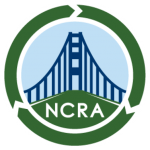By Greg Dudish, Dudish Consulting
Images…
On August 18, Chris of South San Francisco Scavenger took 25 NCRA members and guests on a fantastic tour of their anaerobic digestion facility. Built in 2015, the facility can process 11,000+ tons per year – using methane produced as energy for the facility and as fuel for the 10+ collection trucks.
One of the first things noticed on the tour is the space constraints. Less than 100 yards away from the digester is a parking structure and the Genentech executive building. These constraints require the facility to have a small footprint with tight odor controls while balancing the need to process as much material as possible. The SMARTFERM technology solves this balancing act.
The key to successful anaerobic digestion is the carbon to nitrogen ratio (C:N) of input material. At SSF, various feedstocks are mixed for this optimized ratio prior to digestion. Generally, brown or woody material has a high ratio and green material or food waste has a low ratio.
While waiting for an available digester chamber, the material is stored in the aeration bay. The bay is under negative pressure (i.e., vacuum) for odor control. Once added to a digestion chamber, a 21 day, 3-phase process begins.
Start: Anaerobic digestion only occurs in a specific temperature range. To bring material into this range, a heat-generating, aerobic decomposition process is started by pumping air into the chamber allowing the material to heat itself up naturally! It’s a clever solution with lower energy requirements than heating up the material with steam or hot air.
Fermentation: Once at the correct temperature, percolate with bacteria from cows’ digestive tracts is sprayed onto the material, starting digestion and producing biogas. The key indicators during fermentation is quality and quantity of methane produced. Unfortunately, high quality doesn’t occur during times of high quantity. To increase quality, CO2 and other components are filtered out.
Termination: After ~20 days, methane production has been greatly reduced and doesn’t make sense to continue. To stop the process, percolate is no longer sprayed onto the material. Air is again added to the chamber but this time to purge the chamber of methane and create a safe/non-explosive environment to open the chamber and allow the removal of digestate.
Remaining digestate is treated in an IVC (In-Vessel Composting) tunnel to compost the material. The tunnel also removes ammonia gas produced and processes it with an acid scrubber where sulfuric acid is sprayed over the gas to precipitate out the ammonia as ammonium sulfate. Scrubbed gas then passes through a BioFilter similar to the flora on a forest floor – removing odors and harmful gases – and into the atmosphere. The compost produced is screened offsite and sold to farms!
Overall, the facility is a great example of anaerobic digestion with space and odor constraints while remaining financially viable.
Although not a substitute for the tour, there is a great YouTube video summarizing the process.
ZERO WASTE ENERGY AND BLUE LINE TRANSFER AWARDED 2015 INNOVATOR OF THE YEAR
Recycling Today, 9/15/15
Zero Waste Energy (ZWE), Lafayette, California, and Blue Line Transfer Inc., South San Francisco, California, were announced as the recipient of the National Waste & Recycling Association’s (NWRA’s) 2015 Recycling Equipment Innovator of the Year for its Blue Line Biogenic CNG Facility atWaste360 Recycling Summit. The award recognizes recycling equipment designers and manufacturers that successfully challenge and advance recycling sector operations through innovation in design and manufacturing that increases the effectiveness or efficiency of recycling equipment and operations. Read more… Recycling Today
